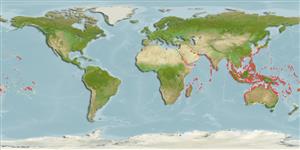Common names from other countries
>
Ovalentaria/misc (Various families in series Ovalentaria) >
Pomacentridae (Damselfishes) > Glyphisodontinae
Etymology: Abudefduf: Arabic, abu = father; this fish is the leader of the reef against other species (Ref. 45335).
More on authors: Quoy & Gaimard.
Environment: milieu / climate zone / depth range / distribution range
Ecologia
marinhas associadas(os) a recifes; oceanódromo (Ref. 51243); intervalo de profundidade 0 - 15 m (Ref. 30874). Tropical; 36°N - 39°S, 26°E - 143°W
Indo-Pacific: Red Sea and eastern Africa to the Line and Tuamoto islands, north to southern Japan, south to Australia. Recorded in Bay of Islands, New Zealand (Ref. 35942). Often confused with the closely related Atlantic species Abudefduf saxatilis (Ref. 7247).
Length at first maturity / Tamanho / Peso / Idade
Maturity: Lm 12.0 range ? - ? cm
Max length : 20.0 cm TL macho/indeterminado; (Ref. 4391)
Descrição breve
Chaves de identificação | Morfologia | Morfometria
Espinhos dorsais (total) : 13; Raios dorsais moles (total) : 12 - 14; Espinhos anais: 2; Raios anais moles: 11 - 13. This species is characterized by having the following features: body depth 1.5-1.8 in SL; forked caudal fin; colour of body blue-green dorsally, shading to silvery white ventrally; five broad bluish black bars the first just behind the head, the narrow fifth on caudal peduncle, the third to fifth extending into the dorsal fin; dorsal part of body between the first and third dark bars often yellow (yellowish hue on anterodorsal part of the body apparent especially during courtship and nesting); caudal fin without dark bands (Ref. 11441, 90102).
Adults inhabit upper edge of outer reef slopes and inshore rocky reefs. Juveniles associated with drifting seaweed (Ref. 12114, 12115). Benthopelagic (Ref. 58302). Feed on zooplankton, benthic algae, and small invertebrates (Ref. 1602). Often in aggregations (Ref. 9710) feeding at midwater or tending nests among rocks and coral ledges (Ref. 90102). In large numbers at spawning sites that are timed with large tides that carry their pelagic offspring far offshore (Ref. 48636). Oviparous, distinct pairing during breeding (Ref. 205). Eggs are demersal and adhere to the substrate (Ref. 205). Males guard and aerate the eggs (Ref. 205). Minimum depth reported taken from Ref. 128797.
Life cycle and mating behavior
Maturities | Reprodução | Spawnings | Egg(s) | Fecundities | Larvas
Oviparous, distinct pairing during breeding (Ref. 205). Eggs are demersal and adhere to the substrate (Ref. 205). Males guard and aerate the eggs (Ref. 205).
Allen, G.R., 1991. Damselfishes of the world. Mergus Publishers, Melle, Germany. 271 p. (Ref. 7247)
Categoria na Lista Vermelha da IUCN (Ref. 130435)
Can't connect to MySQL database (fbapp). Errorcode: Too many connections
